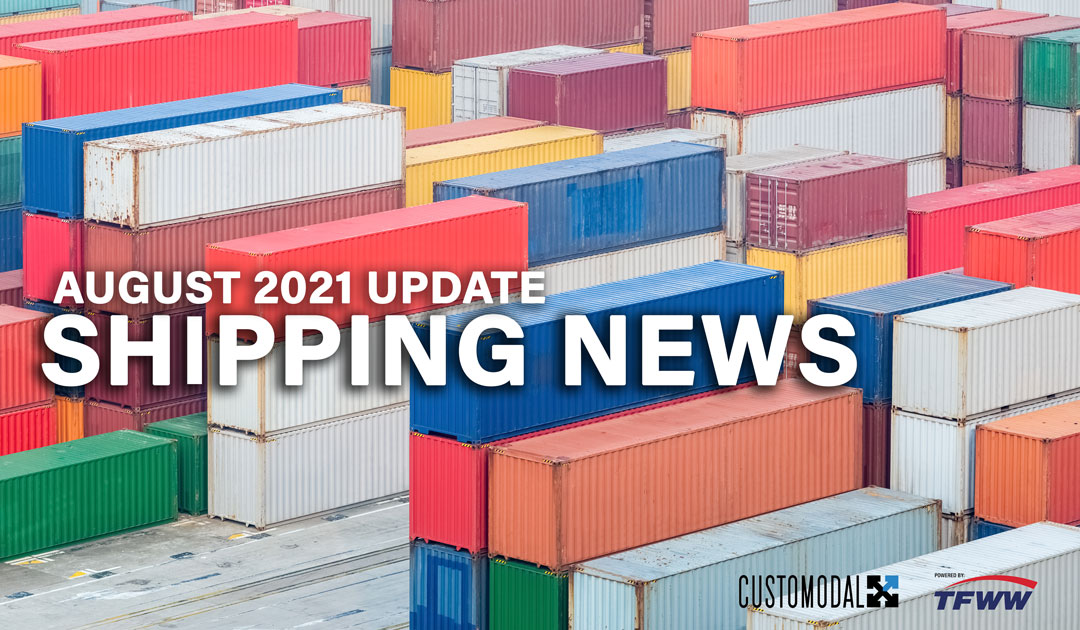August 2021 Shipping Industry Update
[et_pb_section fb_built=”1″ admin_label=”section” _builder_version=”3.22″][et_pb_row admin_label=”row” _builder_version=”3.25″ background_size=”initial” background_position=”top_left” background_repeat=”repeat”][et_pb_column type=”4_4″ _builder_version=”3.25″ custom_padding=”|||” custom_padding__hover=”|||”][et_pb_text admin_label=”Text” _builder_version=”4.9.10″ background_size=”initial” background_position=”top_left” background_repeat=”repeat” hover_enabled=”0″ sticky_enabled=”0″]August is “back-to-school” season which also means August is the peak vacation month in many of our clients’ factories. But August is also the traditional beginning of peak season for import shipments to the United States. And to top it all off, the news reports are full of stories about rising Covid numbers, a “4th wave” and the need to mandate vaccination.
Economy overall
The July 2021 PMI report continues to show the economy is growing, although at a slowing rate of change. A bright spot, employment changes from contracting to growth in July. Here is the breakout of the components:
- Growing (slower): New Orders, Production, Prices, New export orders, Imports
- Growing (faster): Order backlog
- Growing (from contracting): Employment
- Slowing (slower): Supplier deliveries
- Contracting (from growing): Inventories
- Too Low (Faster) Customer’s inventories
Supply Chain
Amazon and Wal-Mart are driving the conversation around warehouse worker shortages and a national minimum wage. Amazon has hired almost 400,000 warehouse workers in the last 12 months, more than 3,000 in Wisconsin alone. What’s more, the average starting wage is north of $15.00/hour. Wal-mart’s hiring and starting wage numbers are similar but Wal-Mart is also offering bonuses to keep workers from jumping. Read more.
An example of the Bullwhip Effect in action…in March 2020 as the pandemic was really beginning medical-equipment suppliers were inundated with orders for new equipment from hospitals and medical service facilities worldwide. Going on 15 months later, with production ramped up in anticipation of that order stream continuing we see inventory filling shelves at suppliers like Cardinal Health and financial reserves for inventory excess highlighting earnings reports.
LTL
- Old Dominion announces they will expand capacity by adding/expanding six terminals
- The LTL industry’s love-hate relationship with over-length freight
FTL
DHL Supply Chain Pricing Power Index at 70 indicating pricing power is tilted toward carriers and expected to remain so over the next 3-month forecast period.
Over the last year, as truckload prices on the spot market spiked, many carriers rejected contract business in favor of spot loads. Now, enough contract business has been “rate adjusted” that tender rejects have dropped off. Net result: Contract rates for recurring lanes are up significantly year-over-year and the spot rate market has seen a reduction in capacity from contract trucks moving back to contract loads allowing the spot market to continue to support higher rates for the time being.
International
AP Moller-Maersk, one of the largest maritime operators in the world, is using record profits from record pricing to acquire additional operations. The maritime industry is notorious for its high barriers to entry (namely the capital requirement). Continued acquisition and consolidation further grows this barrier and increases the industry’s pricing power and disconnects that pricing power from the traditional business cycle.
Containerized shipping, since its pioneering days, has improved productivity immensely. But the pandemic has certainly mucked that up! From labor shortages to skyrocketing prices the container ecosystem has been “off” without signs of recovery. Read more here about how the pandemic has left containers bottled up in distribution chokepoints.
Parcel
The big parcel operators…Fedex, UPS, and DHL…traditionally roll out GRI’s (general rate increases) early each year. The pandemic has seen these operators swallow.
Expedite
Capacity shortages in both LTL and full truckload are causing challenges with responsive pickup times or dependable delivery transits is pushing more freight demand over to the expedited channel. While more expensive than LTL or full truckload, the customer service value of meeting delivery commitments or ensuring inbound materials are on-hand for production is increasingly worth it. But are expedite operators ready?
Contact the Customodal team to learn what this news means for your business!


